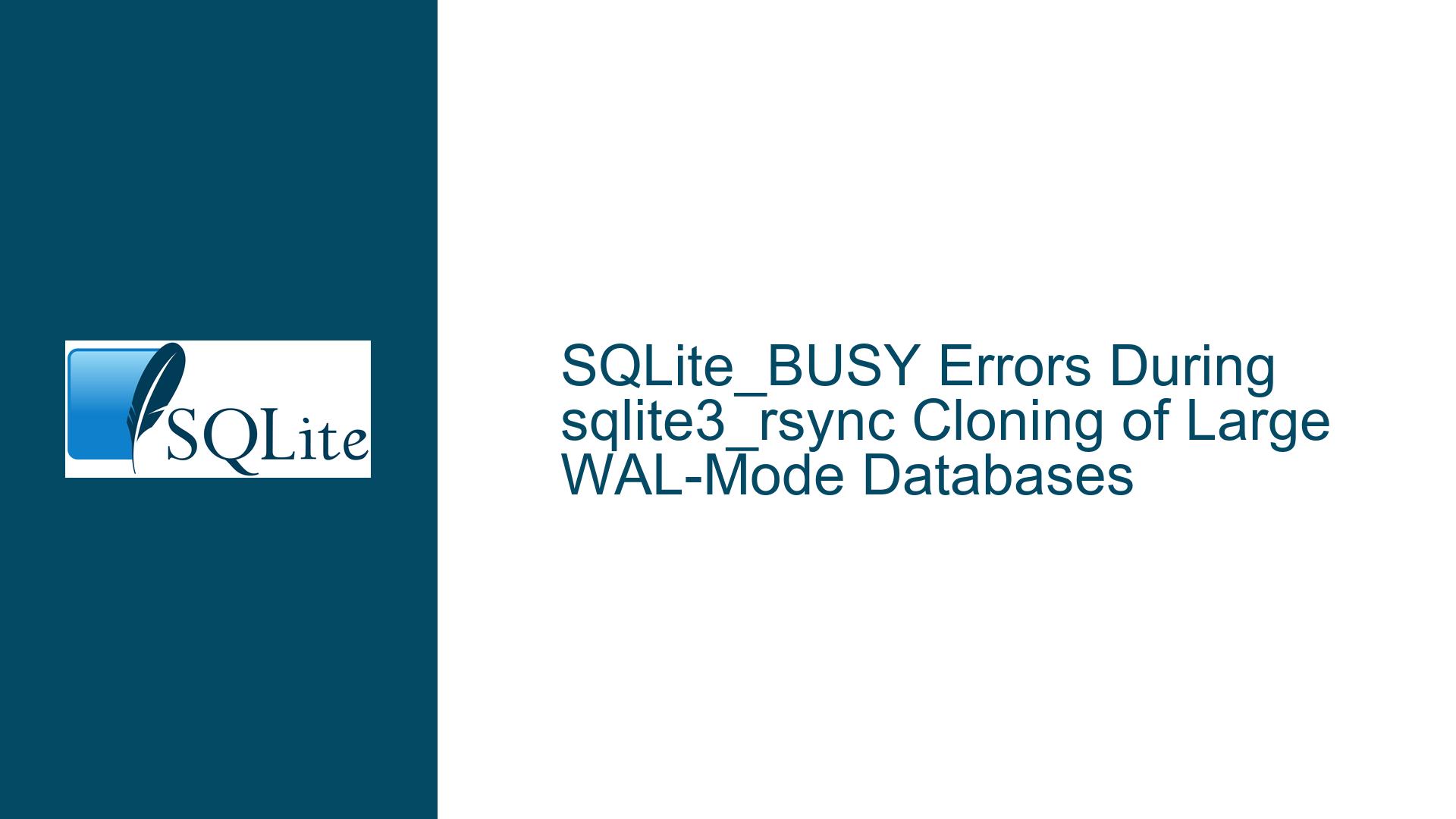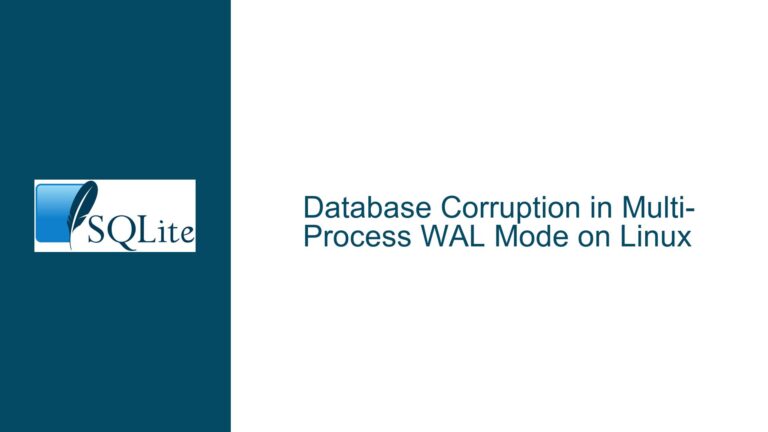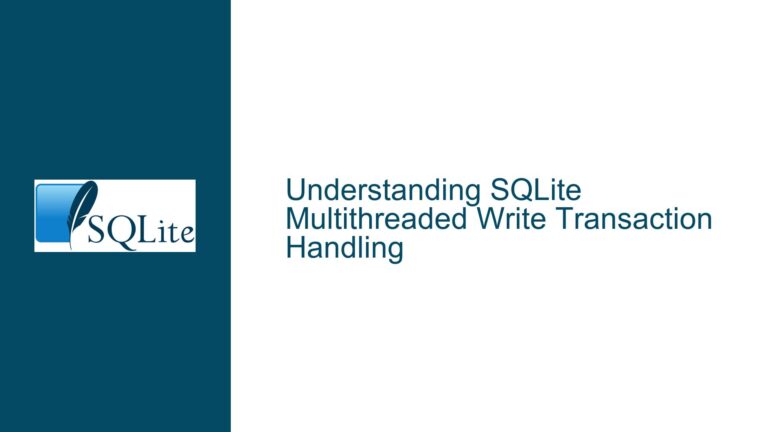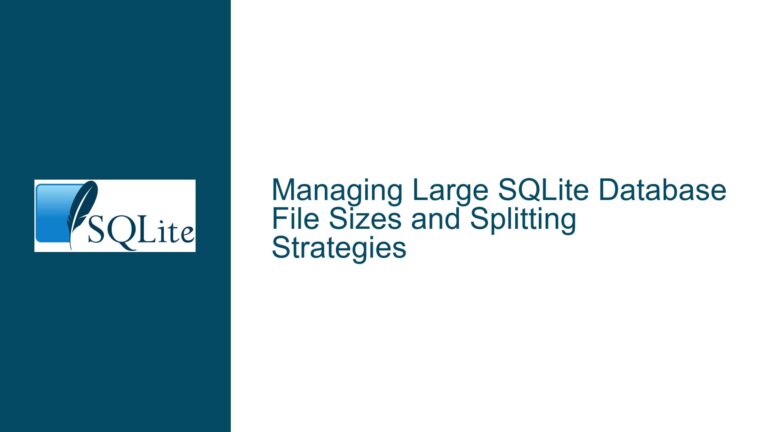SQLite_BUSY Errors During sqlite3_rsync Cloning of Large WAL-Mode Databases
SQLite_BUSY Errors During Concurrent Database Cloning and Writes
When working with SQLite databases in Write-Ahead Logging (WAL) mode, particularly in scenarios involving large databases (e.g., 100GB) and concurrent operations, the SQLITE_BUSY error can become a significant hurdle. This error typically occurs when SQLite is unable to acquire a lock on the database file, which is essential for ensuring data consistency during read and write operations. In the context of using sqlite3_rsync to clone a large database while the source database is actively being written to by a Windows service application, the SQLITE_BUSY error can manifest due to several underlying factors.
The primary issue arises from the interaction between the sqlite3_rsync process and the Windows service application. The sqlite3_rsync tool is designed to create a clone of the database by reading the source database file. However, when the source database is in WAL mode, the presence of a long-running read transaction (initiated by sqlite3_rsync) can interfere with the normal operation of the Windows service application, which may be attempting to write to the database. This interference can lead to SQLITE_BUSY errors, especially if the WAL file grows large and triggers checkpointing operations.
The WAL mode in SQLite is designed to allow concurrent read and write operations by maintaining a separate log file (the WAL file) where changes are recorded before being applied to the main database file. However, this mode also introduces complexities related to lock management and checkpointing. When the WAL file reaches a certain size, SQLite attempts to checkpoint the changes from the WAL file back into the main database file. This checkpointing process requires exclusive access to the database file, which can conflict with the long-running read transaction initiated by sqlite3_rsync.
In summary, the SQLITE_BUSY error in this scenario is likely caused by the interaction between the long-running read transaction initiated by sqlite3_rsync and the checkpointing process triggered by the growing WAL file. This interaction can prevent the Windows service application from acquiring the necessary locks for write operations, leading to the SQLITE_BUSY error.
Long-Running Read Transactions and WAL Checkpointing Conflicts
The SQLITE_BUSY error in this context can be attributed to several interrelated factors, primarily revolving around the behavior of WAL mode, the nature of long-running read transactions, and the checkpointing process.
Long-Running Read Transactions
When sqlite3_rsync initiates a clone operation, it starts a long-running read transaction on the source database. This read transaction is necessary to ensure that the clone is consistent with the source database at the point in time when the clone operation began. However, this long-running read transaction can interfere with other operations on the database, particularly write operations.
In WAL mode, read transactions do not block write transactions, and vice versa. However, when a read transaction is long-running, it can prevent the WAL file from being checkpointed. This is because the checkpointing process requires that all read transactions that started before the checkpoint began must complete before the checkpoint can proceed. If the read transaction initiated by sqlite3_rsync is still ongoing, the checkpoint process will be blocked, leading to a growing WAL file.
WAL Checkpointing
Checkpointing is a process in which changes recorded in the WAL file are applied to the main database file, and the WAL file is then truncated. This process is essential for maintaining the size of the WAL file and ensuring that the database can recover from crashes. However, checkpointing requires exclusive access to the database file, which can conflict with other operations.
When the WAL file grows large, SQLite will attempt to checkpoint the changes back to the main database file. However, if a long-running read transaction is in progress, the checkpoint process will be blocked until the read transaction completes. This can lead to a situation where the WAL file continues to grow, and the checkpoint process is repeatedly delayed, causing increased contention for database locks.
Lock Contention and SQLITE_BUSY Errors
The SQLITE_BUSY error occurs when SQLite is unable to acquire a lock on the database file. In the context of WAL mode, this can happen when a write operation attempts to acquire a write lock on the database file, but the lock is held by another process (in this case, the checkpoint process). The checkpoint process, in turn, may be blocked by the long-running read transaction initiated by sqlite3_rsync.
This lock contention can lead to a situation where the Windows service application, which is attempting to write to the database, is unable to acquire the necessary locks and thus encounters a SQLITE_BUSY error. The presence of sqlite3_rsync exacerbates this issue because it introduces a long-running read transaction that can block the checkpoint process, leading to increased lock contention and a higher likelihood of SQLITE_BUSY errors.
Mitigating SQLITE_BUSY Errors with PRAGMA Settings and Database Backup Strategies
To address the SQLITE_BUSY errors encountered during the concurrent operation of sqlite3_rsync and the Windows service application, several strategies can be employed. These strategies focus on optimizing the WAL mode settings, managing the checkpointing process, and ensuring that the database remains accessible for both read and write operations.
Implementing PRAGMA journal_mode and WAL Settings
One of the first steps in mitigating SQLITE_BUSY errors is to optimize the WAL mode settings using SQLite’s PRAGMA statements. The journal_mode PRAGMA can be used to control the behavior of the WAL file, while the wal_autocheckpoint PRAGMA can be used to manage the checkpointing process.
PRAGMA journal_mode
The journal_mode PRAGMA can be set to WAL to enable Write-Ahead Logging, which allows for concurrent read and write operations. However, in scenarios where long-running read transactions are present, it may be necessary to adjust the WAL settings to reduce the likelihood of SQLITE_BUSY errors.
PRAGMA journal_mode=WAL;
PRAGMA wal_autocheckpoint
The wal_autocheckpoint PRAGMA controls the automatic checkpointing of the WAL file. By default, SQLite will automatically checkpoint the WAL file when it reaches a certain size (typically 1000 pages). However, in scenarios where long-running read transactions are present, it may be beneficial to reduce the size of the WAL file to minimize the impact of checkpointing on database performance.
PRAGMA wal_autocheckpoint=100;
This setting reduces the size of the WAL file to 100 pages, which can help to reduce the frequency of checkpointing and minimize the likelihood of SQLITE_BUSY errors.
Managing Checkpointing Manually
In addition to adjusting the automatic checkpointing settings, it may be necessary to manually manage the checkpointing process to ensure that it does not interfere with the operation of the Windows service application. This can be done using the sqlite3_wal_checkpoint function, which allows for manual checkpointing of the WAL file.
int sqlite3_wal_checkpoint(sqlite3 *db, const char *zDb);
By manually checkpointing the WAL file at strategic points in the application’s operation, it is possible to reduce the likelihood of SQLITE_BUSY errors. For example, the checkpointing process could be initiated during periods of low database activity, or after the completion of critical write operations.
Implementing Database Backup Strategies
Another approach to mitigating SQLITE_BUSY errors is to implement a robust database backup strategy that minimizes the impact of the backup process on the operation of the Windows service application. This can be achieved by using SQLite’s Online Backup API, which allows for the creation of a backup of the database while it is still in use.
The Online Backup API provides a way to create a consistent snapshot of the database without blocking other operations. This can be particularly useful in scenarios where the database is large and the backup process takes a significant amount of time.
int sqlite3_backup_init(sqlite3 *pDest, const char *zDestName, sqlite3 *pSource, const char *zSourceName);
int sqlite3_backup_step(sqlite3_backup *p, int nPage);
int sqlite3_backup_finish(sqlite3_backup *p);
By using the Online Backup API, it is possible to create a backup of the database without interfering with the operation of the Windows service application. This can help to reduce the likelihood of SQLITE_BUSY errors and ensure that the database remains accessible for both read and write operations.
Optimizing Application Logic
Finally, it may be necessary to optimize the application logic to reduce the likelihood of SQLITE_BUSY errors. This can involve adjusting the way that the application handles database transactions, particularly in scenarios where long-running transactions are present.
For example, the application could be modified to use shorter transactions, or to break up large transactions into smaller, more manageable chunks. This can help to reduce the likelihood of lock contention and minimize the impact of long-running transactions on the operation of the database.
Additionally, the application could be modified to handle SQLITE_BUSY errors more gracefully. For example, the application could implement a retry mechanism that attempts to acquire the necessary locks multiple times before giving up. This can help to ensure that the application remains responsive even in the presence of SQLITE_BUSY errors.
Conclusion
In conclusion, the SQLITE_BUSY errors encountered during the concurrent operation of sqlite3_rsync and the Windows service application can be mitigated through a combination of optimizing WAL mode settings, managing the checkpointing process, implementing robust database backup strategies, and optimizing application logic. By carefully managing the interaction between the long-running read transaction initiated by sqlite3_rsync and the checkpointing process, it is possible to reduce the likelihood of SQLITE_BUSY errors and ensure that the database remains accessible for both read and write operations.






